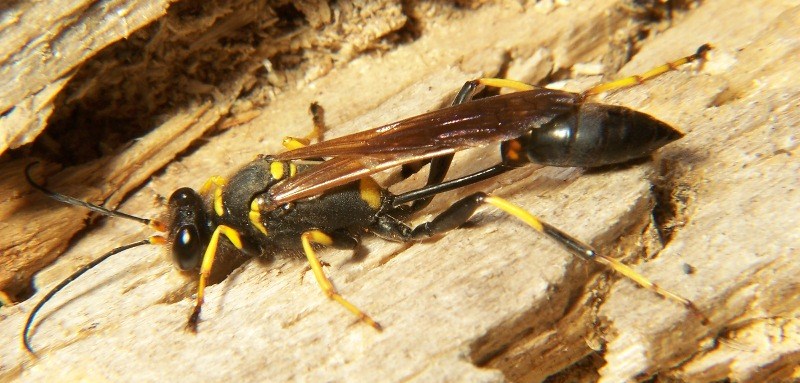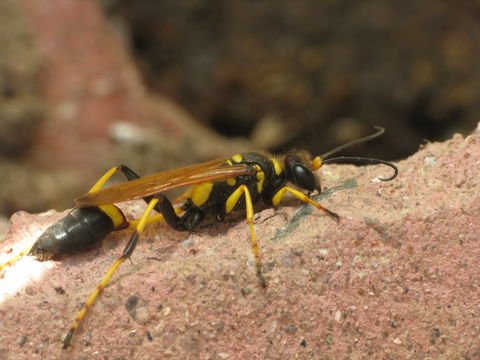Classification
Kingdom: Animalia
Phylum: Arthropoda
Subphylum: Hexapoda
Class: Insecta
Order: Hymenoptera
Family: Sphecidae
Genus: Sceliphron
Species: Sceliphron caementarium
Sceliphron caementarium is also known as the black and yellow mud dauber. Caementarium means "mason or builder of walls" in Latin. Sceliphron caementarium has become known as the black and yellow mud dauber because of the black and yellow coloring of the body. Mud dauber comes from the fact that Sceliphron caementarium uses mud to construct their nests (Bartlett 2004).

Pictured above is a visual representation of the phylogeny of Sceliphron caementarium. The diagram was made by the authors of the site. Although it is hard to see, the diagram shows the complexity of the taxonomic levels that Sceliphron caementarium belongs to.
Eukarya: The domain eukarya contains all organisms whose cells contain a membrane-bound nucleus (Hickman et al 2009).
Animalia: The domain animalia contains eukaryotic, multicellular and heterotrophic organisms that have tissue specialization and reproduce sexually (Encyclopedia of Life 2012).
Arthropoda: The phylum Arthropoda is the largest and most diverse animal phylum. All arthropods have bilateral symmetry with segmented bodies, and they have paired appendages on each segment. The segmented body is divided into functional groups called tagmata that include the head, thorax and abdomen. Arthropods are protostomes and have a triploblastic body with a reduced coelom. Arthropods have a complete digestive system, muscular system and a nervous system that contains a dorsal brain connected by a ring to a nerve chain of ventral ganglia. They have highly developed sense organs with compound eyes. Respiration varies greatly but is accomplished through the body surface, gills, tracheae or book lungs. The circulatory system is open and includes a dorsal heart, arteries and hemoocoel. They are covered by an exoskeleton that is mostly made of chitin and tanned proteins. As arthropods grow, they shed their exoskeleton in a process called ecdysis (Hickman et al 2009).
Hexapoda: Sceliphron caementarium belongs to the subphylum hexapoda because it has six uniramous legs. Hexapods also have paired appendages on the head and thorax, and the number of appendages on the abdomen is much smaller compared to other arthropods (Encyclopedia of Life 2012).
Hymenoptera: The order hymenoptera includes ants, bees and wasps. They have two narrow forewings with two hind wings hooked to them. Wings can also be absent. They have specialized mouthparts for chewing and sucking. The females have an ovipositor that can be modified into a stinger, piercer or saw. Hymenoptera contains both social and solitary species. The young develop through complete metamorphosis with a larval stage of legless, blind and maggot-like organisms (Encyclopedia of Life 2012).
Sphecidae: The family sphecidae consists of solitary wasps that all posses stingers that are used for self defense and to paralyze prey. They can be black, brown or blue with yellow or white markings, and they range in size. Most construct underground nests but others make nests out of mud that are usually attached to buildings. They prey on moth and sawfly larva, crickets, spiders and grasshoppers (Encyclopedia of Life 2012).
Sceliphron: Sceliphron are solitary wasps that construct their nests out of mud. They generally do not sting unless they are threatened (Encyclopedia of Life 2012).
Sceliphron caementarium: Sceliphron caementarium is commonly known as the black and yellow mud dauber. Their nests are made of mud and are comprised of cylindrical cells that contain a single egg and a spider. The female seals the cells with mud and does not return (Encyclopedia of Life 2012).
To learn more about where the black and yellow mud dauber normally is found, go to the habitat page!

